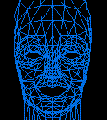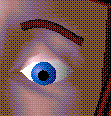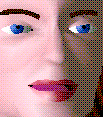 |
 |
 |
 |
 |
 |
 |
 |
 |
 |
 |
 |
The core result of this project is the ability to create
believable animations of human facial expressions employing a polygonal
facial mesh.
Using localized motion cues such as raising or lowering the eyebrows or
lip corners, we produce the six universal emotions:
happiness, sadness, surprise, anger, fear, and disgust.
The facial cues can also be combined in new ways to
produce a wide variety of different emotions.
To bring realistic detail to our model, we have modeled
the hair, eyebrows, the eyes with pupil and iris, and a pseudo-tongue.
A Syn-Thespian is a synthesized digital actor, actress, animal, or
acting-thing.
A large number of applications for syn-thespians lie in the entertainment industry.
But just as synthesized voices are used in
commercial applications over the telephone,
syn-thespians may find much work in
human computer interaction applications especially with
the rise of virtual reality.
Just as a human thespian must communicate effectively with various
facial poses, the same is true for syn-thespians.
Animating the expressions is one large step toward the
creation of syn-thespians.
John Rankin and Richard Hall, A Simple Naturalistic Hair Model,
Computer Graphics, Feb. 1996.
Nadia Magnenat-Thalmann, et al, "Complex Models for Animating Syntheic
Actors", IEEE Computer Graphics & Applications,
September 1991, pg 33-44.
Abstract
Introduction: Syn-Thespians
Animating human faces is one of the greatest challenges in
computer graphics, and has been the target of numerous attempts.
Humans generate various expressions through subtle and not-so subtle
motions of various facial muscles and the jaw.
The greater difficulty lies in not
generating recognizable facial expressions,
but having the viewer believe in them;
humans are the harshest possible critics due to their
intimacy and familiarity with the human face.
References
M.J. Black and Y. Yacoob,
Tracking and Recognizing Rigid and Non-Rigid Facial Motions
using Local Parametric Models of Image Motions,
ICCV, 1995.
Maintained by: Heji Kim and Dan Hung.
Last updated: 4/20/96.